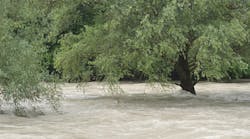About the author:
Ezekiel Rochat is vice president of marketing for PerfectWater, Residential, and Rainwater Resources, Commercial. Rochat can be reached at [email protected].
Matthew and April Lowrance of Knoxville, Tenn., loved the idea of rainwater harvesting when they discovered it on Key Biscayne off the coast of Miami, where it was a local standard. This remained true years later when building their new home, a farmhouse in the rural countryside of East Tennessee. Rainwater harvesting would soon supply their home as the primary potable water source for drinking, washing, bathing, cooking and more. Not only because they wanted the best water, but also because their home's location could have provided low water pressure.
End of the Municipal Water Line
Tennessee state law requires water utilities to provide 20 psi minimum at the meter. It is rare for pressure to reach the low level of 20 psi, however, if one is near the end of a municipal water line, far from the utility, it is possible. Utilities are not responsible for the water pressure going into the home; they only are responsible for the pressure at the meter.
In the case of the Lowrance residence, the situation was two-fold. First, they were in a rural area, far from the utility supply. Second, their home was hundreds of feet up hill from the meter, which could provide a strain on the municipal water supply pressure and flow.
They brought the idea of rainwater harvesting to their builder, who then contacted Tennessee-based PerfectWater. The home was a well-suited application for rainwater harvesting, boasting a 5,000 sq-ft roof footprint. After seeing a project feasibility analysis, which included local rainfall data, demand calculations, home measurements, land survey, water reserve capacity, and project recommendations, the residents chose rainwater harvesting as the primary potable supply for the entire home.
RELATED: Dropping By #40: Diving in to Rainwater Harvesting
New Construction
The system was designed and fitted with the home and residents in mind. Likewise, the home was arranged to integrate the rainwater harvesting system seamlessly. Roof selection was the first design issue to be addressed, as the roofing material is critical to the success of a rainwater harvesting system. Most general roof types, such as tin, slate, tile and asphalt shingles, work well. Some asphalt shingles use algaecides that render those materials unusable for a potable rainwater harvesting system. A tin roof was selected that met the NSF P151 certification-the certification for rooftop rainwater harvesting coating materials-and ANSI/NSF Standard 61-a general standard that applies to materials that encounter potable water.
Standard 6-in. K-style gutters feed the downspouts that connect to PVC pipe just above grade. These connections use downspout adapters that are sealed completely. The underground conveyance, which delivers the captured rainwater from the downspouts to the pre-storage filter and storage, was designed with a minimum of 1% fall without disrupting landscape design, outdoor structures and turf.
A major component for every rainwater harvesting system is the storage vessel. For this project, five 1,700-gal underground storage tanks were chosen to meet the system design requirements. Infiltrator IM-series potable water tanks were used to meet water quality standards and underground specifications. The footprint required for placement of the storage tanks was 34 by 17 ft—a significant amount of space—but due to the underground placement, a section of the backyard was chosen that would be covered with grass and used for backyard activities, out of sight.
Sustainable System Design
One of the features the Lowrance’s were drawn to throughout the process was the closed-system design that controlled the rainwater from the downspouts to the faucet. This system process acts as a filter, removing the need for chemical additives to the water being stored or the potable product water. If the rainwater was simply stored, it would quickly become discolored, slimy, odorous, and require continuous maintenance and advanced water filtration methods. Rather, the system design maintained clear, odor-free, and slime-free water using multiple components and a naturally forming biofilm. The biofilm is a healthy layer of bacteria that cultivates at the bottom of the storage vessel, maintaining odor-free and clear water quality while in storage.
Storage components included a pre-storage filter that removes dirt and debris from entering the storage vessel, while highly oxygenating the inbound water. A smoothing inlet allowed the water to enter the tank without disturbing the biofilm. A floating filter intake also is used for water leaving storage to the house. This device pulls water about 6-in. below the water surface, where the water is at its best, and never disturbs the biofilm. Finally, a specialty overflow was installed to allow excess water to leave the tank without letting other “undesirables” enter.
When the residents use water, it is drawn through a floating filter intake, which captures the water 6 in. below the surface, where it is at its best. It then is pumped to the filtration and controls panel, where the water enters a three-stage filtration process, passing through sediment filtration, carbon filtration, and an ultraviolet light system that eliminates possible bacteria, providing microbiologically safe water at every faucet, appliance and fixture.
The product of a well-designed rainwater harvesting system is healthy, pure, naturally soft rainwater that is low in total dissolved solids and high quality.
Positive Outcomes
In the East Tennessee hills, an average of 50 in. of annual rainfall provides the residents with roughly 144,850 gal of water every year. The family of five uses roughly 90,000 gal of water, but it also uses the harvested rainwater for agricultural purposes on their farm. The 8,500 gal of water storage allows for an extensive reserve in case of drought. While the need would be uncommon, PerfectWater recommended an automatic crossover to the municipal water source available, which would be activated in case of severe drought. However, even 1 in. of rain on the 5,000-sq-ft roof provides the family with 2,897 gal of water, which equals about two weeks of water supply.
"In the rare case that the water does switch over to municipal water, our whole family can tell that it’s happened-the taste, feel, and quality completely changes; we love our rainwater," said Matt Lowrance.
The system was installed in May of 2017, and it has provided approximately 289,700 gal of naturally soft, great-tasting water at a low cost.




